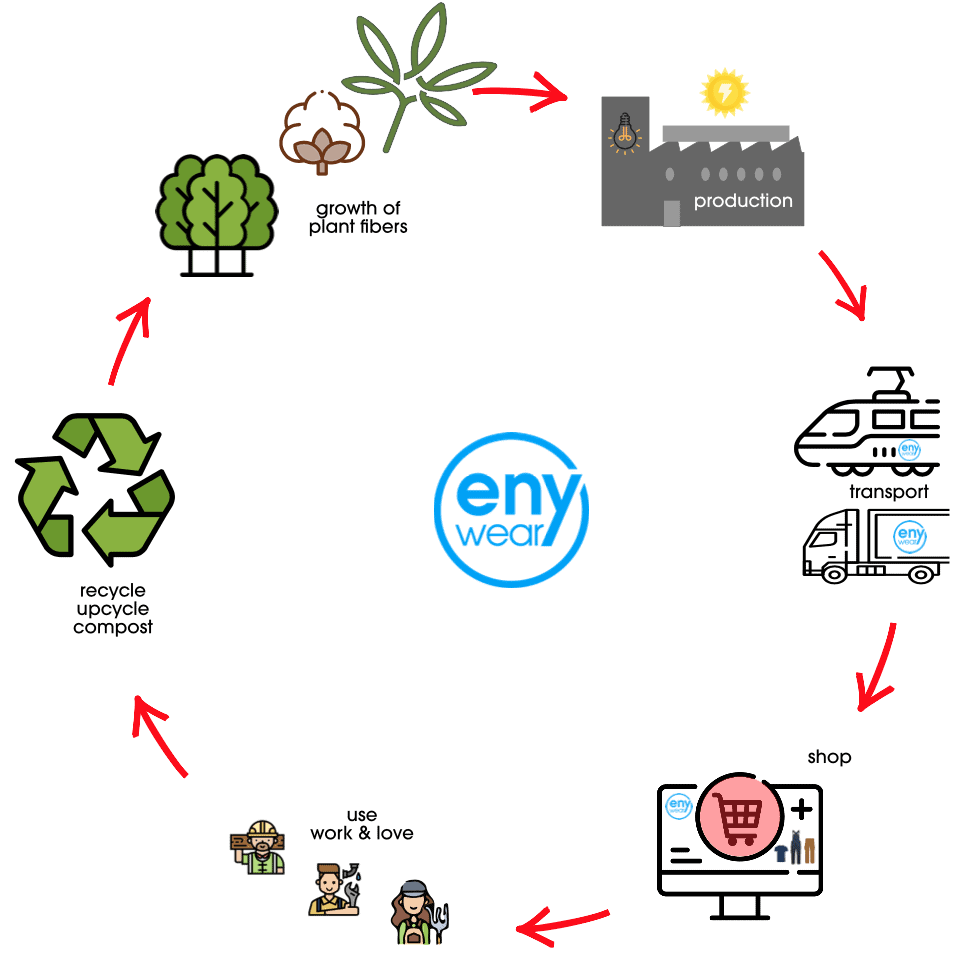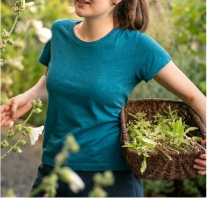A circular economy is discussed a lot and, unlike a linear economy, is a proper sustainable module.
The fashion industry is a part of our economy with a very high use of resources. The area under cultivation for fibers is in direct competition with food and fuel. Consumption of water and power is high in all part of the production chain, transport comes on top. The main driver is transport from the manufacturer to the customer, i.e., from Asia to middle Europe. But even more counts the transport between single production steps, mainly across multiple country borders. Every single production site should be classified as sustainable. If a T-Shirt has traveled 3-5 countries from cotton crop, spinning, weaving, and dying, the carbon footprint is massive, and sustainability gets lost.
Next to plant fibers, clothing contains polyester or other synthetic fibers, especially sportswear or work wear. The classical white doctor’s coat mostly contains 50% polyester.

1. What is circular economy
A circular economy works in closed loops and is efficient. Products are developed so that they return to the cycle after their use. „cradle to cradle“[1] is the extreme module of a circular economy, developed end of 1990. That means from cradle to cradle. The principle is that products are either biological nutrients for the natural circle or can be kept as technical materials continually in the loop.
This means for cloth that fibers can be reused or they are biologically bio-degradable. Almost all cloths consist of mixed fibers, partly coated with synthetic materials. The more complex a material is the more difficult becomes the reuse or recycling. All fabric parts below 5% must not be named on the care label.
There are 92 Mio. Tons of clothing trash every year.
- 1% of that is recycled into new cloth.
- 8% ist Second-Hand cloth
- 10% is recycelt primarily as filling fabrics or cleaning rag
- 82% goes to land fill or is burned
That results in 75 Mio. Tons of land fill[2] of cloth. Every year. This an unbelievable amount.
Meanwhile, the clothing industry partly understands its responsibility. New collections are now made with recyceled fabrics. Its interesting to understand that there’s a difference in pre-consumer and post-cosumer recycling material, meaning cloth after use (post-consumer) or new fabrics directly from production or stock. This concerns wrong or over-production and other remaining stock. The industry takes its responsibility mostly due to the pressure of the customers. Consumer is more interested in the consequences of consumption, and they want not only to shop anymore but also to consume sustainably.
2. Repair, reuse, swap…
Every piece of cloth becomes more sustainable by prolonged use. Wear your jeans, shirts, skirts, shoes as long as possible. And if you don’t like your cloth any more or they don’t fit, donate, lend, swap or give it to second hand shops. Second-hand is a good source for your own need and is fun too, a little like a treasure hunt. The very last choice is the container for cloths.
Upcycling is the topic before cloths gets recyceled: From old jeans you can make new bags, cushions, or cloth. You need a sewing machine and a little bit of exercise. Or maybe just creativity and ambition.
Care of cloth is an important part of circularity. Take care of your cloth gently. Don’t overload landry machines, use low temperatures and low spin cycle of 800. This way, energy is saved, and cloth is treated gently.
3. Why do we need a closed loop?
“Linear economy is the actual economic module mostly used in our society. The life of goods is linear: Products are manufactured, purchased, used and finally disposed or recyceled. Linear economy is our »throughaway society«, and stands for massive consumption and ephemerality instead of conscious purchasing, longlife goods and sustainability. Most producers want to sell as much as possible – neglecting product quality and environment. The resulting waste is not taken into account.”[3]
The actual economy module is on the cost of next generations. We need a future that works also for our grandchildren. The legislation is forcing the requirements to create sustainable products. The fashion industry is a major driver of waste and is first in focus of the EU.[4]
4. The future is clean
Many brands use sustainability, circular economy and ecology as a marketing tool. Products and especially cloth sell better if they carry a green label, or the products are named „eco“, „green fashion“ etc.
Certificates help to understand but the high number is quite confusing. It needs a combined action of stricter law, certificates and a personal check of your preferred brand to take a safe decision.
We have today already a load of cloth, worn and unused, not sellable. Altogether, these valuable goods should return to the production loop at best. It’s most important to make new cloth or funiture fabrics etc out of these valuable resources. That is today very limited, very energy intense, and expensive.
Many reasons for the overstock of trash in fashion:
- Recycling or upcycling is not a standard process
- new fibers are much cheaper compared to recycled ones
- the disposal of cloth is cheap
Many universities, companies, and startups are looking into this topic. There is a reason for the hope that we will be able to use our “gold” in the form of used cloth in a better way in the future.
[1] https://de.wikipedia.org/wiki/Cradle_to_Cradle
[2] https://www.umweltinstitut.org/mitmach-aktionen/slow-fashion-ratgeber.html
[3] https://www.gruenewirtschaft.at/2021/06/11/kreislaufwirtschaft/
[4] https://ec.europa.eu/growth/sectors/fashion/textiles-and-clothing-industries/legislation_en




Comments (0)